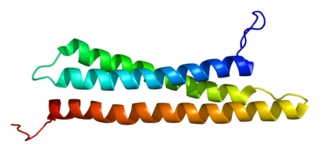Syntaxin-6 is a protein that in humans is encoded by the STX6 gene. [5] [6]
Syntaxin-6 is a protein that in humans is encoded by the STX6 gene. [5] [6]
STX6 has been shown to interact with SNAP23, [7] VAMP3 [8] and VAMP4. [8]
The protein domain Syntaxin 6 N terminal protein domain is a soluble N-ethylmaleimide-sensitive factor attachment protein receptor (SNARE) found in endosomal transport vesicles. It is part of the family, of target SNAREs (t-SNAREs). It is a vital aid to exporting and importing cell cargo through a process called cell trafficking. Its SNARE motif shows significant homology to both syntaxin 1a and S25C, indicating similarity through evolutionary conservation. The structure of the syntaxin 6 N-terminal domain shows strong structural similarity with the N-terminal domains of syntaxin 1a, Sso1p, and Vam3p; despite a very low level of sequence similarity. SNARE functions essentially as a tether to hold the vesicle. The cytoplasmic regions of SNARE found on transport vesicles and target membranes interact, then a four-helix coiled coil forms. This links the cell membrane and vesicles together in such a way that it overcomes the energetic barrier to fusing two lipid bilayers. This is the way cell cargo is exchanged. This particular entry focuses on the N-terminal domain of Syntaxin 6. [9]
Members of this entry, which are found in the amino terminus of various SNARE proteins, adopt a structure consisting of an antiparallel three-helix bundle. Their exact function has not been determined, though it is known that they regulate the SNARE motif, as well as mediate various protein-protein interactions involved in membrane-transport. [10]
SNAREs play a vital role in the trafficking of cell cargo. The vesicles fuse to the cell membrane with the help of SNARE proteins. The SNARE motifs form a four-helix bundle that contributes to the fusion of two membranes. More specifically, the N-terminal domain binds to the SNARE motif, and this intramolecular interaction decreases the rate of association with the partner SNARE. However the N terminal domain's function still remains to fully elucidated. [10]

SNARE proteins – "SNAPREceptor" – are a large protein family consisting of at least 24 members in yeasts, more than 60 members in mammalian cells, and some numbers in plants. The primary role of SNARE proteins is to mediate vesicle fusion – the fusion of vesicles with the target membrane; this notably mediates exocytosis, but can also mediate the fusion of vesicles with membrane-bound compartments. The best studied SNAREs are those that mediate the neurotransmitter release of synaptic vesicles in neurons. These neuronal SNAREs are the targets of the neurotoxins responsible for botulism and tetanus produced by certain bacteria.

Synaptosomal-Associated Protein, 25kDa (SNAP-25) is a Target Soluble NSF Attachment Protein Receptor (t-SNARE) protein encoded by the SNAP25 gene found on chromosome 20p12.2 in humans. SNAP-25 is a component of the trans-SNARE complex, which accounts for membrane fusion specificity and directly executes fusion by forming a tight complex that brings the synaptic vesicle and plasma membranes together.

Syntaxin 11, also known as STX11, is a human gene that is a member of the t-SNARE family.

Syntaxin-1A is a protein that in humans is encoded by the STX1A gene.

Synaptosomal-associated protein 23 is a protein that in humans is encoded by the SNAP23 gene. Two alternative transcript variants encoding different protein isoforms have been described for this gene.

Syntaxin-4 is a protein that in humans is encoded by the STX4 gene.

Vesicle-associated membrane protein 2 (VAMP2) is a protein that in humans is encoded by the VAMP2 gene.

Syntaxin-binding protein 1 is a protein that in humans is encoded by the STXBP1 gene. This gene encodes a syntaxin-binding protein. The encoded protein appears to play a role in release of neurotransmitters via regulation of syntaxin, a transmembrane attachment protein receptor. Mutations in this gene have been associated with infantile epileptic encephalopathy-4.

Syntaxin-7 is a protein that in humans is encoded by the STX7 gene.

N-ethylmaleimide-sensitive factor Attachment Protein Alpha, also known as SNAP-α, is a SNAP protein that is involved in the intra-cellular trafficking and fusing of vesicles to target membranes in cells.

Vesicle-associated membrane protein 3 is a protein that in humans is encoded by the VAMP3 gene.

Syntaxin-5 is a protein that in humans is encoded by the STX5 gene.

Syntaxin-2, also known as epimorphin, is a protein that in humans is encoded by the STX2 gene.

Syntaxin-12 is a protein that in humans is encoded by the STX12 gene.

Vesicle-associated membrane protein 8 is a protein that in humans is encoded by the VAMP8 gene.

Syntaxin-8 is a protein that in humans is encoded by the STX8 gene. Syntaxin 8 directly interacts with HECTd3 and has similar subcellular localization. The protein has been shown to form the SNARE complex with syntaxin 7, vti1b and endobrevin. These function as the machinery for the homotypic fusion of late endosomes.

Golgi SNAP receptor complex member 1 is a protein that in humans is encoded by the GOSR1 gene.

Vesicle-associated membrane protein 4 is a protein that in humans is encoded by the VAMP4 gene.

Syntaxin 3, also known as STX3, is a protein which in humans is encoded by the STX3 gene.

Syntaxin-10 (STX10) is a SNARE protein that is encoded by the STX10 gene. This protein is found in most vertebrates but is noticeably absent from mice. As with other SNARE proteins, STX10 facilitates vesicle fusion and thus is important for intracellular trafficking of proteins and other cellular components. More specifically, STX10 has been implicated in endosome to Golgi trafficking of the mannose 6-phosphate receptor and glucose transporter type 4.